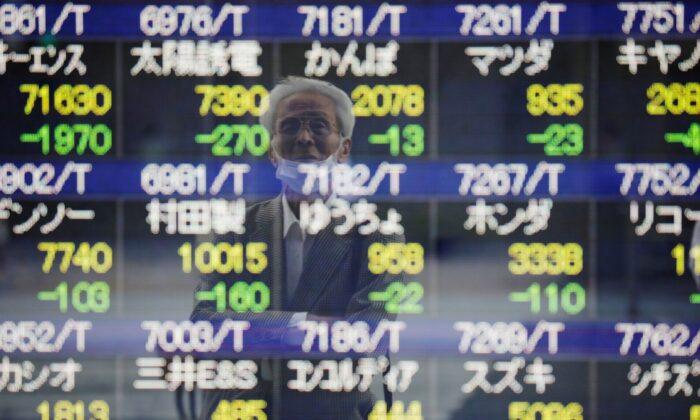LONDON—European shares fell on Wednesday after three straight days of gains, as signs in bond markets of pain ahead for the U.S. economy tempered hopes of a negotiated end to the Ukraine conflict.
The broad Euro STOXX 600 fell 0.6 percent after three positive sessions that had taken the index back to levels reached before Russia invaded Ukraine.
Benchmark indexes in Frankfurt and Paris lost 1.5 percent and 1 percent respectively, with London shares also slipping a touch.
Bond investors had bet overnight that aggressive tightening of policy by the U.S. Federal Reserve could harm the world’s biggest economy over the longer term.
The widely tracked U.S. 2-year-10-year Treasury yield curve briefly inverted on Tuesday for the first time since September 2019.
Longer-dated yields falling below shorter ones indicate a lack of faith in future growth, with 10-year yields falling beneath 2-year rates widely viewed as a harbinger of recession.
Market players said the signals coming from bond markets were at odds with the mood in equity markets.
“It’s a complete diversion of fixed income and the equity market,” said Sebastien Galy, senior macro strategist at Nordea Asset Management.
“Equity markets are overly optimistic and the fixed income markets are probably being overly pessimistic.”
An inverted Treasury curve has in recent decades been followed by a recession within two years, including the 2020 downturn caused by the COVID-19 pandemic.
A day after rising above 0 percent for the first time since 2014, Germany’s two-year bond yield was up six basis points at 0.01 percent—keeping the previous day’s highs in sight.
Shares rallied in Asia and Wall Street overnight after Ukraine had proposed on Tuesday that it take on neutral status, seen as a sign of progress in face-to-face peace negotiations.
On the ground, however, reports of attacks continued and Ukraine reacted with skepticism to Russia’s promise in negotiations to scale down military operations around Kyiv.
MSCI’s broadest index of Asia-Pacific shares outside Japan rose 1.3 percent to its highest in nearly a month, with most Asian stock markets in positive territory.
Yet the rally fizzled, with U.S. S&P 500 futures turning negative and pointing to losses of about 0.3 percent.
“I’m very worried that U.S. equities do not price any risk of slowdown in the U.S. economy—that is extremely worrying,” said Ludovic Colin, a senior portfolio manager at Swiss asset manager Vontobel.
Japan in Focus
The benchmark U.S. 10-year yield was last at 2.4128 percent, having risen as high as 2.557 percent on Monday for its highest since April 2019, as traders positioned themselves for quickfire increases to interest rates by the U.S. Federal Reserve.The impact of rising U.S. yields played out elsewhere, dragging Japanese government bond yields in their wake in a threat to Japan’s ultra-loose monetary policy.
The Bank of Japan increased efforts to defend its key yield cap on Wednesday, offering to ramp up buying of government bonds across the curve, including unscheduled emergency market operations.
The widening gap between U.S. and Japanese yields has caused the yen to weaken sharply, but it managed to regain some lost ground on Wednesday.
The Japanese currency rose 0.9 percent to 121.80 per dollar, compared with Monday’s low of 124.3, amid concerns Japanese authorities might step in to bolster the yen.
Elsewhere in currency markets, the euro rose 0.6 percent to $1.1157, its highest in four weeks, supported by the Russia-Ukraine peace talks.






Friends Read Free